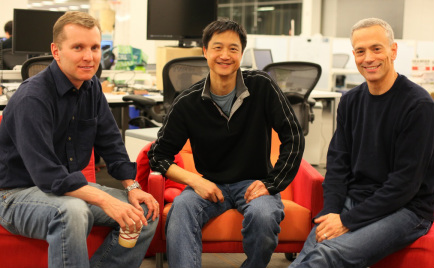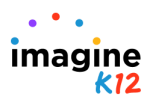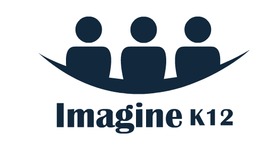by Geoff Ralston

Just over three years ago, Tim Brady, Alan Louie, and I approached Paul Graham with the idea of creating a "Y Combinator for education." We were prepared for summary rejection. Paul does not hold back if he thinks an idea is bad, and we had serious reservations of our own. Was a vertical accelerator a good idea? Were there enough edtech companies to populate one? Did we know enough about accelerators to run one? As it turns out, Paul was not only enthusiastic about the idea, he offered to help us get started by showing us how YC works, by sharing great edtech companies with us, and by helping Imagine K12 launch. He also helped us pick our name!
A short time later Imagine K12 was born, and we were live with a website, an online application, and a really, really bad logo:
A short time later Imagine K12 was born, and we were live with a website, an online application, and a really, really bad logo:
Despite the logo and hastily generated website, the applicants began to show up. Our first cohort launched that summer, and now five cohorts later we have worked with 54 great companies, the vast majority of which are still alive (sadly, six are no longer operating). Three years into this venture, so many things are new and different that a moment of reflection seems deserved. Let’s start with the overall environment.
Education Technology
It is an overstatement to say that edtech has been transformed over the past three years, but there is no doubt that change is happening rapidly. We take little credit for this change, except perhaps the amazing proliferation of new edtech accelerators that we seem to have launched. (There are now twelve.) But equally impressive is the growing reach of edtech companies. MOOCs (Massive Open Online Courses) are serving a global audience via providers like Udacity and Coursera. Tools like Edmodo and Imagine K12’s own ClassDojo have enjoyed impressive viral spread throughout the US school system, and there was even an edtech IPO (Chegg).
The country is moving shakily towards adoption of the Common Core, and the government seems committed to true broadband connectivity via the ConnectEd initiative (supported by industry’s Education Superhighway). One-to-one classes (where every student has a laptop, iPad, or other device) are increasingly common, although the economics of implementation means that more often than not these classes are found only in the wealthiest schools. And innovative teaching methods enabled by technology, from the flipped classroom to hybrid models, continue their spread.
With the edtech landscape shifting and changing, Imagine K12 has not remained static either.
Our Team
We are still three partners, but our friend and original cofounder Alan Louie is no longer one of them. Alan left Imagine K12 to focus on literacy and early childhood education, and our first employee, Karen Lien, was promoted to partner. We also created a new position, manager of educational partnerships, and Jonathan Jew-Lim has done a fantastic job in the role. At the same time, our program has significantly evolved.
Our Program
The basic structure, derived from YC, has not changed. We continue to attract great speakers like PG, Jeff Weiner, Dan Rosensweig, and Reid Hoffman to our weekly dinners. We have added an Educator Demo Dayearly in the program where founders demo/pitch their products to an audience of teachers, principals, and administrators.
The program itself now runs only once a year in the fall, rather than twice in the winter and summer. Demo day is in January followed by rolling admissions for the next fall’s session. We also raised a Start Fund which writes an $80,000 note to each company accepted to Imagine K12. Finally, we are about to move offices from Palo Alto to Redwood City (thanks for three great years, AOL).
Our Results
Imagine K12 companies have had a serious impact on the world of education. ClassDojo is used in hundreds of thousands of classrooms, as are Remind101 and Socrative. Hapara is used in thousands of schools around the world and CodeHS is rapidly changing how programming is taught in middle schools and high schools around the country. Bloomboard and TeachBoost are professional development platforms of the future used to help teachers improve, and Panorama Education provides tools that allow schools to measure their own performance and use that knowledge to improve.
These are just a few examples of the dozens of Imagine K12 companies who have raised tens of millions of dollars and most importantly are making a difference for schools, teachers, and children around the US and the world. Actually, upon reflection, that was the goal all along.
Education Technology
It is an overstatement to say that edtech has been transformed over the past three years, but there is no doubt that change is happening rapidly. We take little credit for this change, except perhaps the amazing proliferation of new edtech accelerators that we seem to have launched. (There are now twelve.) But equally impressive is the growing reach of edtech companies. MOOCs (Massive Open Online Courses) are serving a global audience via providers like Udacity and Coursera. Tools like Edmodo and Imagine K12’s own ClassDojo have enjoyed impressive viral spread throughout the US school system, and there was even an edtech IPO (Chegg).
The country is moving shakily towards adoption of the Common Core, and the government seems committed to true broadband connectivity via the ConnectEd initiative (supported by industry’s Education Superhighway). One-to-one classes (where every student has a laptop, iPad, or other device) are increasingly common, although the economics of implementation means that more often than not these classes are found only in the wealthiest schools. And innovative teaching methods enabled by technology, from the flipped classroom to hybrid models, continue their spread.
With the edtech landscape shifting and changing, Imagine K12 has not remained static either.
Our Team
We are still three partners, but our friend and original cofounder Alan Louie is no longer one of them. Alan left Imagine K12 to focus on literacy and early childhood education, and our first employee, Karen Lien, was promoted to partner. We also created a new position, manager of educational partnerships, and Jonathan Jew-Lim has done a fantastic job in the role. At the same time, our program has significantly evolved.
Our Program
The basic structure, derived from YC, has not changed. We continue to attract great speakers like PG, Jeff Weiner, Dan Rosensweig, and Reid Hoffman to our weekly dinners. We have added an Educator Demo Dayearly in the program where founders demo/pitch their products to an audience of teachers, principals, and administrators.
The program itself now runs only once a year in the fall, rather than twice in the winter and summer. Demo day is in January followed by rolling admissions for the next fall’s session. We also raised a Start Fund which writes an $80,000 note to each company accepted to Imagine K12. Finally, we are about to move offices from Palo Alto to Redwood City (thanks for three great years, AOL).
Our Results
Imagine K12 companies have had a serious impact on the world of education. ClassDojo is used in hundreds of thousands of classrooms, as are Remind101 and Socrative. Hapara is used in thousands of schools around the world and CodeHS is rapidly changing how programming is taught in middle schools and high schools around the country. Bloomboard and TeachBoost are professional development platforms of the future used to help teachers improve, and Panorama Education provides tools that allow schools to measure their own performance and use that knowledge to improve.
These are just a few examples of the dozens of Imagine K12 companies who have raised tens of millions of dollars and most importantly are making a difference for schools, teachers, and children around the US and the world. Actually, upon reflection, that was the goal all along.


 RSS Feed
RSS Feed